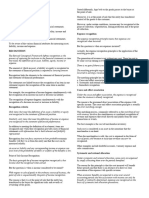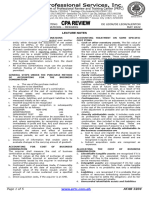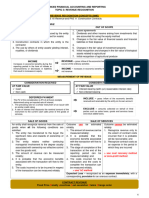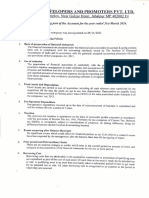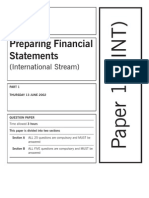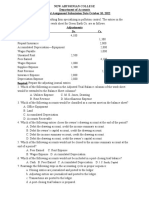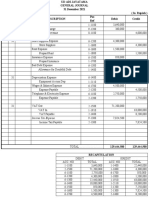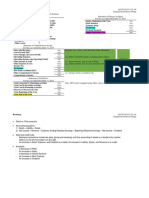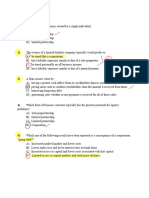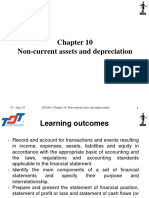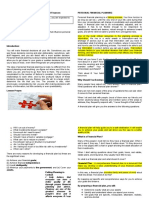0 ratings0% found this document useful (0 votes)
21 viewsAcc124 Week 1 Ulo D
Acc124 Week 1 Ulo D
Uploaded by
Baby Leonor Razonable1. The key elements reported in financial statements are assets, liabilities, equity, income, and expenses. Assets and liabilities must be probable and reliably measurable to be recognized.
2. Revenue is recognized when earned, such as at the point of sale when risks and rewards of ownership transfer. Expenses are recognized when incurred.
3. Income and expenses must be probable and reliably measurable to be recognized. Revenue arises from ordinary business activities like sales, while gains come from non-ordinary sources.
Copyright:
© All Rights Reserved
Available Formats
Download as DOCX, PDF, TXT or read online from Scribd
Acc124 Week 1 Ulo D
Acc124 Week 1 Ulo D
Uploaded by
Baby Leonor Razonable0 ratings0% found this document useful (0 votes)
21 views3 pages1. The key elements reported in financial statements are assets, liabilities, equity, income, and expenses. Assets and liabilities must be probable and reliably measurable to be recognized.
2. Revenue is recognized when earned, such as at the point of sale when risks and rewards of ownership transfer. Expenses are recognized when incurred.
3. Income and expenses must be probable and reliably measurable to be recognized. Revenue arises from ordinary business activities like sales, while gains come from non-ordinary sources.
Original Title
ACC124 WEEK 1 ULO D
Copyright
© © All Rights Reserved
Available Formats
DOCX, PDF, TXT or read online from Scribd
Share this document
Did you find this document useful?
Is this content inappropriate?
1. The key elements reported in financial statements are assets, liabilities, equity, income, and expenses. Assets and liabilities must be probable and reliably measurable to be recognized.
2. Revenue is recognized when earned, such as at the point of sale when risks and rewards of ownership transfer. Expenses are recognized when incurred.
3. Income and expenses must be probable and reliably measurable to be recognized. Revenue arises from ordinary business activities like sales, while gains come from non-ordinary sources.
Copyright:
© All Rights Reserved
Available Formats
Download as DOCX, PDF, TXT or read online from Scribd
Download as docx, pdf, or txt
0 ratings0% found this document useful (0 votes)
21 views3 pagesAcc124 Week 1 Ulo D
Acc124 Week 1 Ulo D
Uploaded by
Baby Leonor Razonable1. The key elements reported in financial statements are assets, liabilities, equity, income, and expenses. Assets and liabilities must be probable and reliably measurable to be recognized.
2. Revenue is recognized when earned, such as at the point of sale when risks and rewards of ownership transfer. Expenses are recognized when incurred.
3. Income and expenses must be probable and reliably measurable to be recognized. Revenue arises from ordinary business activities like sales, while gains come from non-ordinary sources.
Copyright:
© All Rights Reserved
Available Formats
Download as DOCX, PDF, TXT or read online from Scribd
Download as docx, pdf, or txt
You are on page 1of 3
ACC124 WEEK 1-3 ULO D equal to the fair value of the asset given or fair
value of the asset received, whichever is clearly
• Elements of financial statements. This refers
evident. In the absence of fair value, the cost is
to the quantitative information reported in the
equal to the carrying amount of the asset given.
statement of financial position and income
statement. B. LIABILITY RECOGNITION PRINCIPLE
The ELEMENTS directly related to the LIABILITY – a present obligation arising from
measurement of FINANCIAL POSITION in the past events the settlement of which is expected
statement of financial position are: to result in an outflow from the entity of resources
embodying economic benefits.
a. ASSET
2 conditions that must be present for the
b. LIABILITY
recognition of a liability
c. EQUITY
1. It is probable that an outflow of economic
The ELEMENTS directly related to the benefits will be required for the settlement of a
measurement of FINANCIAL PERFORMANCE
present obligation.
in the income statement are:
2. The amount of obligation can be measured
a. INCOME
reliably.
b. EXPENSE
Obligations may be legally enforceable as
EQUITY is the residual interest in the a consequence of a binding contract or statutory
assets of the entity after deducting all of the requirement.
liabilities. Constructive obligations arise from
normal business practice, custom and a desire to
RECOGNITION OF ELEMENTS maintain good business relations or act in an
Recognition means the reporting of an equitable manner.
asset, liability, Income or expense in the face Ways to settle present obligations
of the financial statements of an entity.
A. payment of cash
A. ASSET RECOGNITION PRINCIPLE
B. transfer of noncash assets
ASSET – a resource controlled by the entity
as a result of past events and from which future C. provision of services
economic benefits are expected to flow to the
D. replacement of the obligation with another
entity.
obligation
2 conditions that must be present for the
E. conversion of the obligation into equity
recognition of an asset
C. INCOME RECOGNITION PRINCIPLE -
1. It is probable that future economic benefits will
Income shall be recognized when earned.
flow to the entity.
INCOME – increase in economic benefit
2. The cost or value of the asset can be
during the accounting period in the form of
measured reliably.
inflow or increase in asset or decrease in liability
Future economic benefit that results in increase in equity, other than
contribution from equity participants.
The future economic benefit embodied in
an asset is the potential to contribute directly or REVENUE – arises in the course of ordinary
indirectly to the flow of cash and noncash regular activities and is referred to by a variety
equivalents to the entity. of different names including sales, fees, interest,
dividends, royalties and rent.
Cost principle
GAINS – represent other items that meet the
Asset should be recorded initially at definition of income and do not arise in the
original acquisition cost. In a cash transaction, course of the ordinary regular activities.
cost is equivalent to the cash payment. In a
noncash or an exchange transaction, the cost is
2 conditions that must be present for the construction contract shall be recognized as
recognition of income revenue and expenses, respectively, by
reference to the stage of completion of the
1. It is probable that future economic benefits will
contract activity.
flow to the entity as a result of an increase in an
asset or a decrease I a liability. 5. Production method
2. The economic benefits can be measured Revenue is recognized at the point of
reliably. production
Point of sale Other income recognition
The two conditions for income recognition Interest revenue- Recognized on a time
are present at the point of sale. Point of sale is proportion basis that takes into account
the point of income recognition. the effective yield of the asset
Royalties- Recognized in an accrual
Revenue from sale of goods
basis in accordance with the substance of
The following conditions should be the relevant agreement.
present for the revenue from sale of goods Dividends- Recognized when the
shareholder’s right to receive payment is
A. The entity has transferred to the buyer the
established, when dividends are declared.
significant risks and rewards of ownership of the
Installation fees- Recognized over the
goods.
period of installation by reference to the
B. the entity retains neither continuing managerial stage of completion.
involvement nor effective control over the goods Subscription revenue- Recognized on a
sold. straight-line basis over the subscription
period.
C. the amount of revenue can be measured
Admission fees- Recognized when the
reliably.
event takes place.
D. it is probable that economic benefits Tuition fees- Recognized over the period
associated with the transaction will flow to the in which tuition is provided.
entity.
D. EXPENSE RECOGNITION PRINCIPLE -
E. the costs incurred or to be incurred in respect Expenses are recognized when incurred.
of the transaction can be measured reliably.
EXPENSE - Decrease in economic benefit
Exceptions to the point of sale during the accounting period in the form of an
outflow or decrease in asset or increase in
1. Installment method liability that result in decrease in equity, other
Revenue is recognized at the point of than distribution to equity participants.
collection. Expenses that arise in the course of ordinary
AMT OF REVENUE = GROSS PROFIT RTE x regular activities include cost of sales, wages
AMOUNT OF COLLECTION and depreciation.
2. Cost recovery method or sunk cost LOSSESS do not arise in the course of
method ordinary regular activities and include losses
Revenue is recognized at the point of resulting from disasters
collection. Conceptual framework: expenses are incurred
3. Cash method when it is probable that a decrease in future
economic benefits related to decrease in an asset
Revenue is recognized when received or an increase in liability has occurred and that
regardless of when earned. the decrease in economic benefits can be
measured reliably.
4. Percentage of completion method
2 conditions that must be present for the
When the outcome of a construction
recognition of income
contract can be estimated reliably, contract
revenue and contract costs associated with the
1. It is probable that a decrease in future - The amount of cash or cash equivalent that
economic benefits has occurred as a result of a could currently be obtained by selling the asset in
decrease in an asset or an increase in a liability. an orderly disposal.
2. The decrease in economic benefits can be E. Present value or future exchange price
measured reliably.
- The discounted value of the future net cash
Matching principle inflows that the asset is expected to generate in
the normal course of business.
Those costs and expenses incurred in
earning a revenue shall be reported in the same
period.
3 applications
1. Cause and effect association- Expense is
recognized when revenue is recognized.
2. Systematic and rational allocation- Some
costs are expensed by simply allocating them
over the periods benefited.
3. Immediate recognition-The cost incurred is
expensed outright because uncertainty of future
economic benefits or difficulty of reliably
associating certain costs with future revenue.
An expense is recognized immediately when:
1. When an expenditure procedure produces no
future economic benefit.
2. When cost incurred does not qualify or ceases
to qualify for recognition as an asset.
MEASUREMENT OF ELEMENTS
Measurement is the process of
determining the monetary amounts at which the
elements of the financial statements are to be
recognized and carried in the statement of
financial position and income statement.
Measurement bases
A. Historical cost or past purchase exchange
price
- The amount of cash or cash equivalent paid or
the fair value of the consideration given to acquire
an asset at the time of acquisition.
B. Current cost or current purchase exchange
price
- The amount of cash or cash equivalent that
would have to be paid if the same or equivalent
asset was acquired currently.
C. Realizable value or current sale exchange
price
You might also like
- Intermediate Accounting 1: a QuickStudy Digital Reference GuideFrom EverandIntermediate Accounting 1: a QuickStudy Digital Reference GuideNo ratings yet
- Module 1 Intermediate Accounting 2Document37 pagesModule 1 Intermediate Accounting 2Andrei GoNo ratings yet
- Conceptual FrameDocument28 pagesConceptual FrameNahian HasanNo ratings yet
- ACCA - Chapter 5-6Document7 pagesACCA - Chapter 5-6Bianca Alexa SacabonNo ratings yet
- ACTG 21B (CH4) - Lecture NotesDocument4 pagesACTG 21B (CH4) - Lecture Notesraimefaye seduconNo ratings yet
- ACCA - Chapter 5-6Document7 pagesACCA - Chapter 5-6Bianca Alexa SacabonNo ratings yet
- Cfas CompreDocument17 pagesCfas CompreLouise John BacudNo ratings yet
- Cfas Chapter 6Document3 pagesCfas Chapter 6danielisaiahasdNo ratings yet
- Chapter 1 Current LiabilitiesDocument5 pagesChapter 1 Current LiabilitiesEUNICE NATASHA CABARABAN LIMNo ratings yet
- Current LiabilitiesDocument3 pagesCurrent Liabilitiesreymonastrera07No ratings yet
- ACCA - Chapter 5-6 (A5)Document6 pagesACCA - Chapter 5-6 (A5)Bianca Alexa SacabonNo ratings yet
- Conceptual Framework (Part 2) : AssetsDocument3 pagesConceptual Framework (Part 2) : AssetsEui KimNo ratings yet
- IA2 NotesDocument7 pagesIA2 NotesAshryle SalazarNo ratings yet
- 3005 Business CombinationDocument4 pages3005 Business CombinationTatianaNo ratings yet
- Afar.3204 - Business Combination MergersDocument4 pagesAfar.3204 - Business Combination Mergersj.galagar.127531.tcNo ratings yet
- ADVACC NOTES - Business CombinationDocument5 pagesADVACC NOTES - Business CombinationAlyaNo ratings yet
- AFAR 03.2 - Revenue Recognition (PFRS FOR SMEs)Document4 pagesAFAR 03.2 - Revenue Recognition (PFRS FOR SMEs)cheoreciNo ratings yet
- Ccfas Chapter 8 15Document5 pagesCcfas Chapter 8 15Ceann RapadasNo ratings yet
- Notes To Account Advaita Developers Pvt. Ltd.Document3 pagesNotes To Account Advaita Developers Pvt. Ltd.Prabhjot AroraNo ratings yet
- Afar.2905 Business Combination Mergers PDFDocument5 pagesAfar.2905 Business Combination Mergers PDFCyrille Keith FranciscoNo ratings yet
- Notes FAR 2Document9 pagesNotes FAR 2ALLYSA DENIELLE SAYATNo ratings yet
- Intermediate Accounting 2Document3 pagesIntermediate Accounting 2Ghie RodriguezNo ratings yet
- Declares A Share Dividend. Share Dividend Payable Is Part of EquityDocument2 pagesDeclares A Share Dividend. Share Dividend Payable Is Part of EquityAsh imoNo ratings yet
- Business Combinations Notes: Topic OutlineDocument4 pagesBusiness Combinations Notes: Topic OutlineMary Jescho Vidal AmpilNo ratings yet
- Chapter 26Document8 pagesChapter 26Mae Ciarie YangcoNo ratings yet
- Chapter 4 - Adjusting AccountsDocument4 pagesChapter 4 - Adjusting AccountsIESHA JAESAMIN TWAYE BASTIANNo ratings yet
- Accounting For Special Transactions ReviewerDocument6 pagesAccounting For Special Transactions ReviewerKaye Mariz TolentinoNo ratings yet
- PRELIMSDocument4 pagesPRELIMSJadon MejiaNo ratings yet
- CfasDocument3 pagesCfasWinnie ToribioNo ratings yet
- P 2Document4 pagesP 2Julious CaalimNo ratings yet
- The Elements Directly Related To The Measurement of Financial Position AreDocument8 pagesThe Elements Directly Related To The Measurement of Financial Position AreKim Patrice NavarraNo ratings yet
- Cfas CH5 To CH7Document7 pagesCfas CH5 To CH7James DarylNo ratings yet
- Intacc 2 NotesDocument25 pagesIntacc 2 Notescoco credoNo ratings yet
- Review 105 - Day 4 Theory of AccountsDocument14 pagesReview 105 - Day 4 Theory of AccountsAndre PulancoNo ratings yet
- FARAP 4509 Trade Payable, Provisions Other Current LiabilitiesDocument11 pagesFARAP 4509 Trade Payable, Provisions Other Current Liabilitieskyhn.beycaNo ratings yet
- KTQNNCDocument40 pagesKTQNNCcamnhu622003No ratings yet
- Definition Explained:: Liabilities A Liability Is ADocument26 pagesDefinition Explained:: Liabilities A Liability Is ACurtain SoenNo ratings yet
- FAR Self-Made ReviewerDocument2 pagesFAR Self-Made ReviewerAngelica SumatraNo ratings yet
- Intacc NotesDocument10 pagesIntacc NotesIris FenelleNo ratings yet
- 6679 Current LiabilitiesDocument3 pages6679 Current LiabilitiesSungkyu KimNo ratings yet
- Chapter 1Document18 pagesChapter 1clarizaNo ratings yet
- ACCOUNTING Reviewer Chapter 3 4Document4 pagesACCOUNTING Reviewer Chapter 3 4hoxhiiNo ratings yet
- CHAPTER 4 Mam CorvsDocument28 pagesCHAPTER 4 Mam CorvsRoniel John Franco RamilNo ratings yet
- PFRS 14 15 16Document3 pagesPFRS 14 15 16kara mNo ratings yet
- Business Combination-Date of AcquisitionDocument13 pagesBusiness Combination-Date of Acquisitionmax pNo ratings yet
- Basic Aspects of Financial AccountingDocument12 pagesBasic Aspects of Financial Accountingsiva reddyNo ratings yet
- Conceptual Framework Module 5Document3 pagesConceptual Framework Module 5Jaime LaronaNo ratings yet
- Fundamentals of Accounting I: Recognition PrinciplesDocument6 pagesFundamentals of Accounting I: Recognition PrinciplesericacadagoNo ratings yet
- D4Document13 pagesD4neo14No ratings yet
- Review 105 - Day 4 Theory of AccountsDocument13 pagesReview 105 - Day 4 Theory of Accountschristine anglaNo ratings yet
- Acc203 - Cfas - 08.19.23Document15 pagesAcc203 - Cfas - 08.19.23Hailsey WinterNo ratings yet
- Part 2 Accounting EquationDocument88 pagesPart 2 Accounting EquationDONALD GUTIERREZNo ratings yet
- Bonds Payable HandoutDocument3 pagesBonds Payable HandoutJeanieNo ratings yet
- Pfrs For Smes Full PFRS: Same Same Same SameDocument14 pagesPfrs For Smes Full PFRS: Same Same Same SameAnthon GarciaNo ratings yet
- 66705studentjournal-Oct2021a (1) - Removed MadarDocument20 pages66705studentjournal-Oct2021a (1) - Removed MadarTimepass MungfuliNo ratings yet
- Cfas ReviewerDocument7 pagesCfas ReviewerslacksheepNo ratings yet
- OMTQM - Chapter 6Document4 pagesOMTQM - Chapter 6Sailah PatakNo ratings yet
- Recognition, Derecognition, Measurement, Presentation and Disclosure of Financial InformationDocument7 pagesRecognition, Derecognition, Measurement, Presentation and Disclosure of Financial InformationMikaela LacabaNo ratings yet
- Textbook of Urgent Care Management: Chapter 46, Urgent Care Center FinancingFrom EverandTextbook of Urgent Care Management: Chapter 46, Urgent Care Center FinancingNo ratings yet
- Survey Questionnaire On Water Refilling StationDocument2 pagesSurvey Questionnaire On Water Refilling StationBaby Leonor Razonable100% (1)
- Survey QuestionnaireDocument2 pagesSurvey QuestionnaireBaby Leonor RazonableNo ratings yet
- CBM 1st Exam Rev.Document9 pagesCBM 1st Exam Rev.Baby Leonor RazonableNo ratings yet
- Financial Market 2NDDocument7 pagesFinancial Market 2NDBaby Leonor RazonableNo ratings yet
- ACC124 - First ExamDocument4 pagesACC124 - First ExamBaby Leonor RazonableNo ratings yet
- Digest Mendoza v. de Guzman 33 Off. Gazette 1505Document1 pageDigest Mendoza v. de Guzman 33 Off. Gazette 1505JureeBonifacioMudanzaNo ratings yet
- Banana Leaf Catering FSDocument2 pagesBanana Leaf Catering FSLeslie CastilloNo ratings yet
- Fabm 1 Ak 11 Q3 0401Document5 pagesFabm 1 Ak 11 Q3 0401Tin CabosNo ratings yet
- Pratical No 14 Edp HKKDocument5 pagesPratical No 14 Edp HKKHKK 169No ratings yet
- EWM SourceDocument2 pagesEWM SourceRaghavendra MJNo ratings yet
- Entrepreneurial Finance UNIT-2.NotesdocxDocument21 pagesEntrepreneurial Finance UNIT-2.Notesdocxnishantbhai8No ratings yet
- Intangible Assets Problems and Solutions2Document22 pagesIntangible Assets Problems and Solutions2Destiny LazarteNo ratings yet
- Act 5Document1 pageAct 5Unknowingly AnonymousNo ratings yet
- Chapter 5Document13 pagesChapter 5Derrick de los ReyesNo ratings yet
- Preparing Financial StatementsDocument6 pagesPreparing Financial StatementsAUDITOR97No ratings yet
- MathematicsDocument16 pagesMathematicsBapa LoloNo ratings yet
- Model Questions Fundamentals of Taxation and Auditing BBS 3rd Year PDFDocument5 pagesModel Questions Fundamentals of Taxation and Auditing BBS 3rd Year PDFShah SujitNo ratings yet
- Lesson 4 Sources of IncomeDocument9 pagesLesson 4 Sources of IncomeErick MeguisoNo ratings yet
- P5 FAC RTP June2013Document105 pagesP5 FAC RTP June2013AlankritaNo ratings yet
- Individual Assignment.123Document5 pagesIndividual Assignment.123Tsegaye BubamoNo ratings yet
- Jawaban Ajp Unit Ud Adi Jayatamaa AciiiiiiiiDocument4 pagesJawaban Ajp Unit Ud Adi Jayatamaa AciiiiiiiiASRI HANDAYANINo ratings yet
- Annual Financial Report Naturgy Energy Group SA 2021Document118 pagesAnnual Financial Report Naturgy Energy Group SA 2021Hossam El DefrawyNo ratings yet
- RoadmapDocument2 pagesRoadmaplamslamNo ratings yet
- Kunci Jawaban Siklus Akuntansi (P1)Document30 pagesKunci Jawaban Siklus Akuntansi (P1)Zulkarnain Zoel75% (4)
- 4.CIR v. General Foods, Inc.Document5 pages4.CIR v. General Foods, Inc.evelyn b t.No ratings yet
- IAS 12 Solutions PDFDocument74 pagesIAS 12 Solutions PDFrafid aliNo ratings yet
- CF Mid Term - Revision Set 3Document10 pagesCF Mid Term - Revision Set 3linhngo.31221020350No ratings yet
- ICAEW - Chapter 10 - Non-Current Assets and DepreciationDocument43 pagesICAEW - Chapter 10 - Non-Current Assets and Depreciationvothituongnhi7703No ratings yet
- Ch18.Outline ShareDocument9 pagesCh18.Outline ShareCahyo PriyatnoNo ratings yet
- United States Court of Appeals Third CircuitDocument13 pagesUnited States Court of Appeals Third CircuitScribd Government DocsNo ratings yet
- PERSONAL-FINANCE-PRELIMS-REVIEWER FinalllllDocument47 pagesPERSONAL-FINANCE-PRELIMS-REVIEWER FinalllllStephanie Andal0% (1)
- Production Budget Solutions: TopicDocument15 pagesProduction Budget Solutions: TopicTonie NascentNo ratings yet
- Mom DocumentDocument172 pagesMom DocumentvaishnaviNo ratings yet
- Gurughasidas Central University, Bilaspur: "Power and Duties of Income-Tax Authorities"Document20 pagesGurughasidas Central University, Bilaspur: "Power and Duties of Income-Tax Authorities"Kishori PatelNo ratings yet
- Parkside ApartmentsDocument25 pagesParkside ApartmentsRyan SloanNo ratings yet







